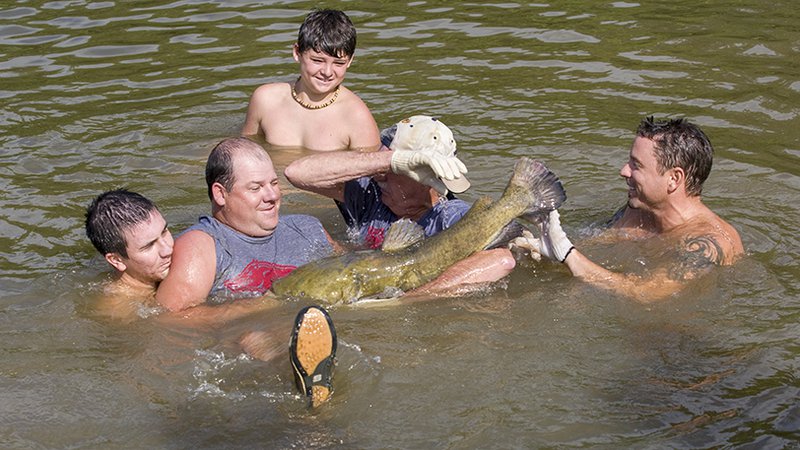Flatheads: Big, good eating and challenging to anglers
BY agfc
ON 07-17-2019

July 17, 2019
LITTLE ROCK – Of the three species of catfish in Arkansas, the flathead may rank at the top, at least in fishermen’s interest.
Flatheads aren’t the most numerous. Channel catfish hold the lead there. Flatheads also aren’t the largest; the blue catfish holds the state record at well over 110 pounds. But flatheads hold a special place in many anglers’ hearts, mainly for their hard-fighting nature and their impressive table quality.
Like many Arkansas fish, flatheads are known by other names here and there – Opelousas cat, Appaloosa cat, yellow cat, shovelhead. Three distinguishing features are the broad, flattened head that gives the fish its name, a square instead of forked tail and a mottled yellowish-brown color in contrast to the gray color of blue cats and channel catfish.
Flatheads are native to Arkansas, primarily the larger river systems. Anglers in the state use three methods to catch them. The most common two ways to fish for them are with a rod-and-reel or with a trotline or jug set on the water. The third method, hogging, is not for the squeamish. Catfish hogging means setting large barrels under the water or digging holes into an undercut bank and reaching in with bare hands to pull the unwilling fish out.
Most Arkansas flatheads are found in flowing water – but this is not an absolute. Lake Conway, for instance, has produced big flatheads for more than 60 years. Flathead fishermen often look for submerged wood like logs and root wads as likely spots for their quarry. If these objects are close to flowing water, chances of finding a flathead may improve.
Flatheads also are usually taken on live bait – but, again, this is not always the case. Many anglers seeking flatheads bait up with small bream including “ricefield slicks,” more formally known as green sunfish. Gizzard shad in bigger sizes are frequently used for flathead work. Anglers using live baitfish should be sure that the bait they use comes from the same lake where they are fishing, as it is illegal to transport live baitfish, such as shad and bream between bodies of water and possibly transmit diseases or accidentally transport an invasive species such as silver carp in their baitwell. Catching bait for flatheads can be an adventure of its own, throwing a cast net for shad, or fishing with tiny jigs to net up a bunch of slicks.
Use large, strong hooks for flatheads, and pick out a good-sized bream or a big shad for the bait. The weight should be heavy enough to get the bait and hook to the bottom of the water quickly.
Like other forms of catfishing, patience is an asset. Flatheads feed by both sight and smell, and fishermen usually toss out the baited hook, let it sink to the bottom and wait. Bobbers are used, and so is the tightlining method. When the line begins to move, the fisherman waits. Catfish of all species have a habit of moving off with the bait in their mouths for several feet, sometimes many feet, before stopping to swallow it.
The general rule is to let the fish take the bait with an open reel. Then when the movement stops, close the reel and set the hook – hard.
Daily limit for catfish set by the Arkansas Game and Fish Commission is 10. This is for any species or a combination of species. A few waters in the state have more generous daily limits but for channel and blue catfish, not flatheads.
The state record for flathead catfish is 80 pounds, set in 1989 with an Arkansas River fish by Wesley White of Hartford. A recent trotline catch on Blackfish Lake in St. Francis County by Preston Gracey of Forrest City on June 10 weighed an impressive 85 lbs. 6 oz. Although Gracey’s catch does not qualify for the rod-and-reel state record, it does hold the record for the largest flathead caught in Arkansas by any tackle.
Recent News
Subscribe to Our Weekly Newsletter E-mails
Don’t miss another issue. Sign up now to receive the AGFC Wildlife Weekly Newsletter in your mailbox every Wednesday afternoon (Waterfowl Reports are published weekly during waterfowl season and periodically outside the season). Fishing Reports arrive on Thursdays. Fill in the following fields and hit submit. Thanks, and welcome!


